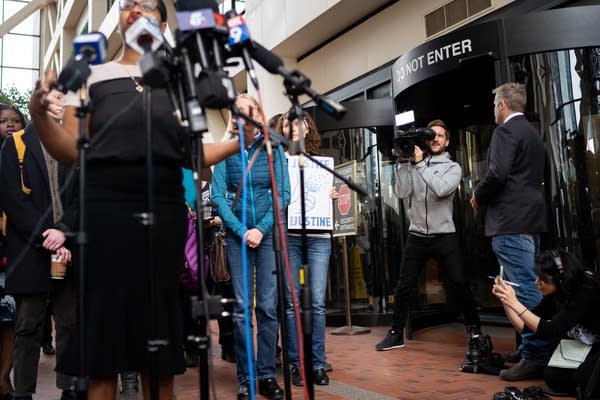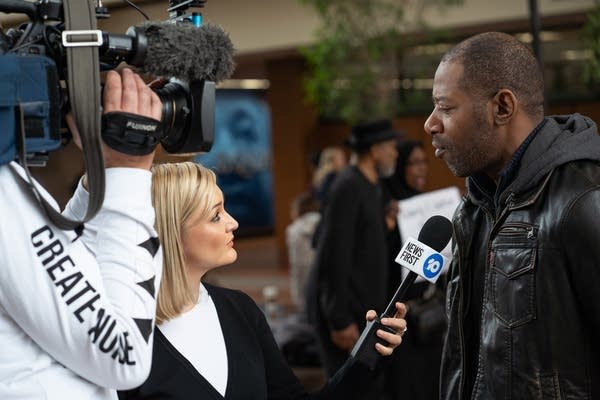Australians struggle to process 'shocking killing'

Go Deeper.
Create an account or log in to save stories.
Like this?
Thanks for liking this story! We have added it to a list of your favorite stories.
Days after Justine Ruszczyk was shot and killed by a police officer in her quiet Minneapolis neighborhood, hundreds of mourners gathered on an Australian beach to remember her.
Ruszczyk had lived near the beach in Sydney before moving to the United States. A friend played the didgeridoo as the sun rose. Family members tossed pink and red flowers into the waves as the tide went out.
Ruszczyk's killing sparked protests and calls for accountability in Minnesota, which had already grappled with a number of high-profile killings by police officers. But in Ruszczyk's native Australia, the response was shock and disbelief.
The circumstances of how a 40-year-old woman had been killed, 9,000 miles away, had horrified Australia.
Turn Up Your Support
MPR News helps you turn down the noise and build shared understanding. Turn up your support for this public resource and keep trusted journalism accessible to all.
On a summer night in 2017, Ruszczyk, who also went by the name Justine Damond, called 911 to report what she thought was an assault behind her Minneapolis home. Mohamed Noor, who at the time was a police officer, responded to the call. He shot her from his squad car.

Malcolm Turnbull, then Australia's prime minister, struggled to process Ruszczyk's death when asked about it at a press appearance.
"How can a woman out in the street in her pajamas seeking assistance from the police be shot like that?" Turnbull said. "It is a shocking killing."
The fact that Ruszczyk was killed by a law enforcement officer gripped the country. One tabloid newspaper blared the headline "American Nightmare" across its front page.
And over the past year in Minneapolis, Australian television crews have aggressively pursued Noor after court appearances, asking why he fired his weapon or even whether he was "innocent of murdering" Ruszczyk. Reporters from Australian news outlets are also in town this week to cover the trial.
Journalist Ben Knight covered the aftermath of Ruszczyk's killing for the Australian Broadcasting Corporation. He told MPR News at the time that his viewers were looking for anything to explain how this could have happened, and why the U.S. doesn't take measures to address it.
"Gun violence in America was a known quantity for sure. But when we look at it happening increasingly from police, that, I think, just adds a new element to it," Knight said. "And once again, you have us over there on the other side of the Pacific, looking over and just scratching our heads."
One reason for the difference between the two countries is simple: guns. Australia passed stricter laws in 1996 after a man killed 35 people at a tourist attraction in Port Arthur, Tasmania. Australia has lower rates of gun owners and lower rates of gun violence than the United States.
This gun culture affects how American police officers approach their jobs, said James Densley, a professor of criminal justice at Metropolitan State University. Police officers are trained to expect that people they encounter will be armed.
"You speak to police officers and police chiefs, they don't want more and more guns on the streets because that puts them at risk," Densley said. "So they are living with the sort of shadow of this over them."

This can lead, Densley said, to police officers doing things like taking their seat belts off so they'll have easier access to their firearms, even though they're more likely to be harmed by a car accident than in a shooting.
"There's this almost irrational fear of the risk that the policing job has, versus where there really is danger, and not taking the proper protocols," Densley said.
There are also important differences between American and Australian law enforcement.
Terry Goldsworthy served as a police officer in the Queensland region of Australia for almost three decades and now teaches criminology. He said there's a cultural difference in how American police engage with the public.
"There is a kind of hardened aggressiveness to public interactions that we don't see over here," Goldsworthy said. "Some of that going on can go back to what we call the militarization of the police, or the rise of the warrior cop."
Australia's police forces are also more centralized than the 18,000 or so mostly independent law enforcement agencies in the United States.
"Those big organizations are better at providing training for the people within them," Goldsworthy said. "I just think it delivers a more professional service."

But Australia has policing problems as well. The Guardian newspaper published an investigation last year that showed frequent deaths of indigenous people being held in police custody, including in juvenile detention centers and prisons. They documented more than 400 deaths of indigenous Australians from everything from medical conditions to injuries between 1991 and 2018.
Still, the number of killings by law enforcement officers in the United States dwarfs the number in other countries, relative to population, including Australia.
At least 1,000 people in the United States are shot to death by police officers each year, according to an ongoing project by the Washington Post. In Australia, that number is almost always in the single digits.



